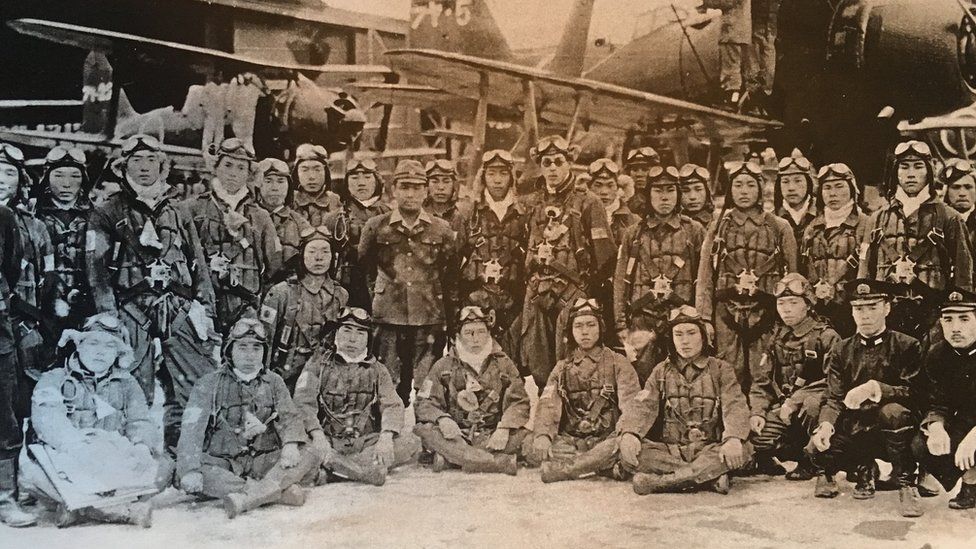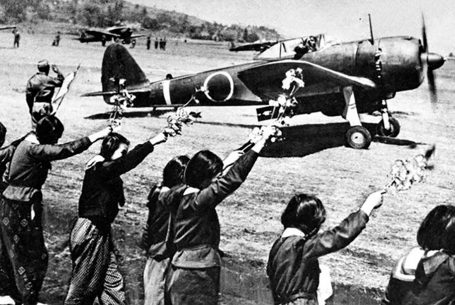*This is a project in context of Reconstruction History at Kyushu University (details at the bottom).

Kamikaze, a term that has sounded through many centuries for different purposes. Though, two significant moments in time have brought forward the most commen association with kamikaze and death. In first instance kamikaze is associated with the godly wind (actually a typhoon) that had destroyed the Mongolian army twice and sank their ships to the bottom of the ocean. In the second instance, kamikaze is associated with the people that flew their last flights into a blnd alley crashing their bodies against the enemies’ ships resulting into them sinking to the bottom of the ocean themselves, never returning to their homeland nor family.
Athough there is an ongoing discussion about whether they were volunteers or not, one cannot simply ignore the fact that it happened and they are never going to return. Many tried to unearth the truth through their writings through translations and analysis of the words used in their poetry. Through their poetry they tried to find who kamikazepilots truly were and what their beliefs could’ve been during the Second World War. Each poem had become a piece of puzzle in search for a greater image that could help us discover what truly could’ve happened during the Second World War.
A samurai warrior who will fall as the flower of the political path led by the tenno (emperor) shall never fail to find flowers alongside the path he takes.
I was born and raised as a brave warrior of His Highness’s nation that governs the world under heaven, today I am going to scatter like flower petals.
For a samurai of the sky who is ready to die for the cause of tenno, his duty, is heavy, while his body is light.
Upon receiving his Majesty’s order in awe and reverence, I came away from my beloved wife’s arms in the middle of the night.
From today on, I shall not look back, for I am setting forth to be humble shield of His Majesty.
If we go to war over the sea, we shall become waterlogged corpses, if we go to war over the mountains, we shall become corpses upon which grass will grow, we shall die by His Majesty’s side, we shall never look back.
Engraving on my heart that my death in this coming mission means a life, I shall be reborn seven times to protect my country.
Though not considered worthwhile flowers when they are in bloom, they shall be counted as one when they fall, such are mountain cherry blossoms (and I).
The poems above are most known for sounding nationalistic and protective of their land. Based on what is written we can agree that they are indeed more pro-Japan. However, it is hard to tell if they truly were meant to be that way. Some suggest that some phrases may have been standardized or some may have been expected to be used at such times. Although these may feel nationalisttisch, there may be a chance that those poems are the result of a feeling of duty for their emperor and land. With this suggestion, one may believe that they had been told to write poetry as such. Though, we must also not forget that these people had been brought up with imperialist Japan since birth and may have not known antything else and therefore wrote such poetry. This practically shows that there is no way to tell the exact truth behind each of those poems an their intentions. Other poems may suggest something else too.
My body may be destined to rot in the field of Musashi, but my Japanese spirit shall be kept forever on this earth.
My parent’s love for me is greater than my love for them, what will they think when they hear today’s news (of my execution)?
I, too, shall forever bloom as the cherry blossoms in Yasukuni Shrine, even though my body is destined to perish in the southern sea.
I, too, shall bloom as cherry blossoms in Yasukuni Shrine along with my comrades, who have scattered in the fields of the battle.
On the day I left my hometow, my mother sent me off with a smile, even though she knew that I would never come home.
I have come this far in high spirits, but I now feel sad when I thinik about my father’s love and kindness that has been poured on me for these many years.
When I think that there is a life connected to mine, my already unbearable sadness becomes much more acute.
Again today, I heard the news of my comrades’ brave deeds, when I ask myself “what am I doing?,” my eyes are filled with tears.
Source: Ito Mayumi. 2007. Japanese Tokko Soldiers and Their Jisei. Master Thesis. University of Alaska Anchorage.
These poems are perfect examples of different intentions of just a few kamikazepilots to show that there is not one answer to answer each question. Although, the poetry may not be black and white they are an essential part of history and can’t be go unnoticed. Personal writings of people from the past are as imporant to be included when writing history. These poems are just as diaries an imporant aspect of the Second World War memory in Japan as well as outside of Japan as they have become wellknown around the world for multiple reasons. Though, some may choose to only believe certain parts of the truth that only fit in their beliefs.
Aside from people’s interpretations or perspectives we can reconstruct parts of the Second World War through these poems. We know that they flew out knowing their mission, duty and time of death. They, may or may not, have believed in the promise that they’d return as dieties at Yasukuni Shrine. At the same time, they have accepted their appearance in forms of cherry blossom petals at the Shrine or any location in Japan, in order to be remembered. In order to be able to do this, the poems are a great help. We get to see a little bit more of a personal side of them as we read through them.
Through these poems we are able to tell that some may have believed strongly that they are shields for the emperor and will protect Japan. Some may have already given up on that belief and wrote about their feelings towards their families and friends hoping to meet again. Although, no names or ages are mentioned, we clearly know that these were young men who flew for Japan and wrote these poems as to leave their last expressions behind. And as they flew out covered in cherry blossoms guided by people’s cheers, they left to fullfil their duty as requested. Whether they had a choice or not, one can say that they were soldiers just like any other soldier existed. Like each soldier, they fulfilled their duty. And so they left behind an image of strong, dedicated, proud young men but deep inside they may have been terrified, sad, doubting their choices as they flew out to their death.
In addition to their image, Yukio Seki is a famous name between them. He was one of the first to fly and criticize the government for the task he was given. I quote: “Japan is finished. Killing such an excellent pilot as me? I could drop a 500-kg bomb on an enemy carrier without having to go down with it. I refuse to die for the emperor or Japan. If I must die, then I will do so for my beloved wife, and no other”.

* I’ve chosen this topic as it is in line with my Undergraduate Thesis (Dutch: Bachelorproef). I’ve tried to give a short summary about the kamikazepilots by answering a few questions: Who were they? What did they do? What did they write? How were they viewed? How are they remembered? Putting this together into a more fluent narrative in the form of a short blog/article.
Written by Ekaterina Buggenhout (Katja) Tomo no Kai’s Webmaster
Summer 2023
